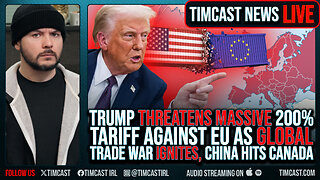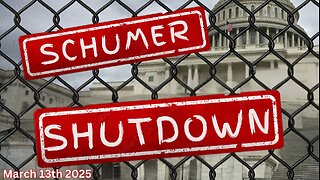Premium Only Content

Obama spent $5 billion paying Ukrainian Neo Nazis' riots (Maidan coup)
The devastating effects of President Obama’s foreign policy toward the Ukraine during his second term in office
His fool-hardy policy has advanced neo-Nazism, racism, hate and terror, not only in the Ukraine, but also in Europe and the United States.
the Strong Points column that were written during his second term is a hard-hitting, poignant, direct and appealing column. It provides opinion on racial, religious, social, political, cultural, artistic and other matters from an African-American progressive perspective
The column is published weekly in several black newspapers and their online posts nationwide
http://www.jamesstrongpoints.com
Russia has seized on remarks by U.S. President Barack Obama about an internationally brokered deal to resolve last year's Ukrainian crisis, claiming they prove that Washington was involved in a "coup" against Ukraine's Moscow-backed president.
In a CNN interview broadcast on February 1, Obama said he thinks Russia has been interfering in Ukraine partly because President Vladimir Putin was "caught off balance" by embattled Ukrainian President Viktor Yanukovych "fleeing after we had brokered a deal to transition power in Ukraine."
Speaking in Beijing on February 2, Russian Foreign Minister Sergei Lavrov said Obama's remarks were "proof that from the very beginning, the United States was involved in the anti-government coup that Obama neutrally described as a 'power transition'."
Lavrov did not explain how Obama's remarks proved his claims.
In Washington, the Obama administration reacted to Lavrov's statement on February 2 by saying that Russia is pushing a “revisionist narrative of the crisis in Ukraine” that is “deeply troubling, but utterly unconvincing.”
A senior administration official told RFE/RL that Obama’s remarks referred to U.S. efforts to help resolve the crisis in the run-up to a February 21, 2014 deal signed by Yanukovych and what was then Ukraine's opposition.
The agreement, brokered by three EU diplomats, called for the creation of a national unity government, a presidential election by December 2014, and a return to an earlier Ukrainian constitution that would have curtailed Yanukovych’s powers.
The official said the United States worked with Yanukovych's government, Ukraine's opposition, and “other stakeholders to reach an agreement to put Ukraine back on track toward fulfilling the aspirations of the Ukrainian people for democracy, respect for human rights, European integration and long-term economic growth.”
The official said: “This effort included not just the United States but Russian and European government representatives as well."
On the day the agreement was signed, the White House said Obama and Putin had spoken by telephone and “exchanged views on the need to implement quickly the political agreement reached" in Kyiv.
Yanukovych, who had triggered mass protests in Kyiv by refusing to sign an EU association agreement in November 2013, abandoned power and fled to Russia shortly after signing the February 21 deal.
Russian state-controlled media on February 2 echoed Lavrov’s interpretation of Obama's remarks in the CNN interview.
The state-run RIA-Novosti news agency covered the story in Russian with the headline Obama Announced That The United States Helped Change Power In Ukraine.
Russia's state-owned English-language news agency Sputnik ran the headline Obama Admits U.S. Role In 2014 Ukraine Coup.
Russia has repeatedly accused the West of sponsoring Yanukovych’s ouster
Obama pumped $5 billion into the country to promote regime change
In a December 2013 speech by Assistant Secretary of State for European and Eurasian Affairs Victoria Nuland to the U.S.-Ukraine Foundation, a non-governmental agency that promotes democracy in the former Soviet republic.
Nuland had returned days earlier from her third trip to Ukraine in five weeks to assess the protests over President Viktor Yanukovych’s policies to move away from the European Union, she said.
She made clear the United States supported the protesters’ fight and spoke of how she met with Yanukovych, pressing him to end the pushback from Ukrainian security forces because it is "absolutely impermissible in a European state, in a democratic state."
She described how American taxpayer money has supported Ukraine’s democratic development despite the country’s challenges.
"Since Ukraine's independence in 1991, the United States has supported
Ukrainians as they build democratic skills and institutions, as they promote civic participation and good governance, all of which are preconditions for Ukraine to achieve its European aspirations," she said. "We have invested over $5 billion to assist Ukraine in these and other goals that will ensure a secure and prosperous and democratic Ukraine."
Her eight-minute speech (video) attracted little to no media attention
Since 1992, the government has spent about $5.1 billion to support democracy-building "programs" in Ukraine with money flowing mostly from the Department of State via U.S. Agency for International Development, as well as the departments of Defense, Energy, Agriculture and others.
The United States does this with hundreds of other countries
More money went to categories with the objectives of "governing justly and democratically" ($800 million), "investing in people" ($400 million), economic growth ($1.1 billion), and humanitarian assistance ($300 million).
The descriptions are a bit vague, which could lead people to think the money was used for some clandestine purpose
the United States’ foreign aid investments, which rival no other country (though supporters note the spending equals (allegedly) only 1% of all federal spending).
The massive check-writing across dozens of agencies to non-governmental organizations to scores of countries and regions around the world is almost impossible to untangle.
"As it stands, it is nearly impossible to find a figure," said Nicole Valentinuzzi, communications manager of Publish What You Fund, a group that pushes for aid transparency across the world. "These kinds of things would be easily verifiable if people were given timely information."
The State Department created ForeignAssistance.gov to help taxpayers, journalists and others find out where the money is going, but the data is limited in the number of years available and not reported by all agencies.
The site started under the Obama administration and is a work in progress
Eight agencies, such as U.S. AID, Millennium Challenge Corporation and the Treasury Department, have begun posting planning and spending data to the site. Still, 14 agencies, including the departments of Agriculture, Energy, Transportation, and Health and Human Services, have not
Some examples? The United States spent about $20 million on Peace Corps programs in Ukraine over the past four years.
It spent about $40 million through U.S. AID on health programs in the countries since 2010 -- fighting HIV/AIDs, malaria and providing for maternal and child health.
The United States spent an additional $80 million or so working on projects related to weapons of mass destruction, according to ForeignAssistance.gov
==========
United States Reaping What It Sowed in Ukraine
February 1 2022
The U.S. government continues sending weapons to Ukraine, escalating the likelihood of war with Russia
The U.S. and NATO’s interest in Ukraine is not really about resolving its regional differences, but about something else altogether
Germany is wisely refusing to funnel more weapons into Ukraine, in keeping with its long-standing policy of not sending weapons into conflict zones.
Ralf Stegner, a senior Member of Parliament for Germany’s ruling Social Democrats, told the BBC that the Minsk-Normandy process agreed to by France, Germany, Russia, and Ukraine in 2015 is still the right framework for ending the civil war.
“The Minsk Agreement hasn’t been applied by both sides,” Stegner said, “and it just doesn’t make any sense to think that forcing up the military possibilities would make it better. Rather, I think it’s the hour of diplomacy.”
By contrast, most U.S. politicians and corporate media have fallen in line with a one-sided narrative that paints Russia as the aggressor in Ukraine, and supports sending more weapons to Ukrainian government forces.
The most critical events that have been airbrushed out of the West’s political narrative are the violation of agreements that Western leaders made at the end of the Cold War not to expand NATO into Eastern Europe, and the U.S.-backed coup in Ukraine in February 2014.
Western mainstream media accounts instead date the crisis in Ukraine back to Russia’s reintegration of Crimea in 2014, and the decision by ethnic Russians in Eastern Ukraine to secede from Ukraine as the Luhansk and Donetsk People’s Republics.
But these were not unprovoked actions; they were responses to the U.S.-backed coup, in which an armed mob led by the neo-Nazi Right Sector militia stormed the Ukrainian parliament, forcing the elected President Viktor Yanukovich and members of his party to flee for their lives.
The remaining members of parliament voted to form a new government, subverting the political transition and plans for a new election that Yanukovich had publicly agreed to the day before, after meetings with the foreign ministers of France, Germany, and Poland.
The U.S. role in managing the coup was exposed by a leaked 2014 audio recording of Assistant Secretary of State Victoria Nuland and U.S. Ambassador Geoffrey Pyatt working on their plans, which included sidelining the European Union and shoehorning in U.S. protege Arseniy Yatsenyuk as prime minister.
Both of Nuland’s hand-picked puppets in Ukraine, Prime Minister Yatsenyuk and President Poroshenko, were soon mired in corruption scandals. Yatsenyuk was forced to resign after two years and Poroshenko was named in a tax evasion scandal revealed in the Panama Papers.
Post-coup, war-torn Ukraine remains the poorest country in Europe, and one of the most corrupt.
The Ukrainian military had little enthusiasm for a civil war against its own people in Eastern Ukraine, so the post-coup government formed new “National Guard” units to assault the separatist People’s Republics.
The infamous Azov Battalion drew its first recruits from the Right Sector militia and openly displays neo-Nazi symbols, yet it continues to receive U.S. arms and training, even after the U.S.
Congress explicitly cut off its funding in the FY2018 Defense Appropriations bill
U.S. allies in Ukraine, with NATO, Azov Battalion, and neo-Nazi flags.
In 2015, the Minsk and Normandy negotiations led to a ceasefire and the withdrawal of heavy weapons from a buffer zone around the separatist-held areas. Ukraine agreed to grant greater autonomy to Donetsk, Luhansk, and other ethnically Russian areas of Ukraine, but it has failed to follow through on that agreement.
A federal system, with some powers devolved to individual provinces or regions, could help to resolve the all-or-nothing power struggle between Ukrainian nationalists and Ukraine’s traditional ties to Russia that has dogged its politics since independence in 1991.
But the U.S. and NATO’s interest in Ukraine is not really about resolving its regional differences, but about something else altogether.
The U.S. coup was calculated to put Russia in an impossible position.
If Russia did nothing, a post-coup Ukraine would sooner or later join NATO, as NATO members had already agreed to in principle in 2008.
NATO forces would advance right up to Russia’s border, and Russia’s important naval base at Sevastopol in the Crimea would fall under NATO control.
On the other hand, if Russia had responded to the coup by invading Ukraine, there would have been no turning back from a disastrous new war with the West.
The United States has given Ukraine $2.7 billion in military aid since 2014, including $650 million since President Biden took office, along with deployments of U.S. and NATO military trainers.
Ukraine has still not implemented the constitutional changes called for in the 2014 and 2015 Minsk agreements, and the unconditional military support that the United States and NATO have provided has encouraged Ukraine’s leaders to effectively abandon the Minsk-Normandy process and simply reassert sovereignty over all of Ukraine’s territory, including Crimea.
In practice, Ukraine could only recover those territories by a major escalation of the civil war, and that was exactly what Ukraine and its NATO backers appeared to be preparing for in March 2021.
In October, Ukraine launched new attacks in Donbass. Russia, which had about 100,000 troops stationed near Ukraine since March, responded with new troop movements and military exercises. U.S. officials launched an information warfare campaign to frame Russia’s actions as an unprovoked threat to invade Ukraine, concealing their own role in fueling the threatened Ukrainian escalation that Russia is responding to.
Underlying all of these tensions is NATO’s expansion through Eastern Europe to the Russian border, in violation of commitments Western officials made at the end of the Cold War.
The U.S. and NATO’s refusal to acknowledge that they have violated those commitments or to negotiate a diplomatic resolution with the Russians is a central factor in the breakdown of U.S.-Russian relations.
If the United States and NATO are not prepared to negotiate new disarmament treaties, remove U.S. missiles from countries bordering Russia, and dial back NATO expansion, Russian officials say they will have no option but to respond with “appropriate military-technical reciprocal measures.”
This expression may not refer to an invasion of Ukraine, as most Western commentators have assumed, but to a broader strategy that could include actions that hit much closer to home for Western leaders.
For example, Russia could place short-range nuclear missiles in Kaliningrad (between Lithuania and Poland), within range of European capitals; it could establish military bases in Iran, Cuba, Venezuela, and other countries; and it could deploy submarines armed with hypersonic nuclear missiles to the Western Atlantic.
Hypersonic nuclear missiles off the U.S. East Coast would put the United States in a similar position to that in which NATO has placed the Russians. China could adopt a similar strategy in the Pacific to respond to U.S. military bases and deployments around its coast.
So the revived Cold War that U.S. officials and corporate media hacks have been mindlessly cheering on could very quickly turn into one in which the United States would find itself just as encircled and endangered as its enemies.
Will the prospect of such a twenty-first century Cuban Missile Crisis be enough to bring U.S. leaders back to the negotiating table, to start unwinding the suicidal mess they have blundered into?
We certainly hope so.
===========
Canada’s role in the blatant coup in Ukraine
Ottawa’s hostility to Ukrainian democracy is a largely ignored element in the tragedy unfolding in that country.
Canada’s multi-year campaign to subvert an elected government was an important factor in producing the conditions that led to where we are today.
The Canadian government encouraged the Maidan protests that toppled president Viktor Yanukovych, leading to an eight-year war that left 14,000 dead.
During the November 21, 2013, to February 22, 2014, uprising, foreign minister John Baird attended an antigovernment rally in Kyiv, Ottawa adopted sanctions and activists were given safe haven in the Canadian embassy for a week. “It really was the most blatant coup in history”, explained George Friedman, CEO of the CIA-aligned Stratfor, in describing Yanukovych’s ouster.
Canada didn’t simply support the three-months-long protest against a president who won elections the Organization for Security and Co-operation in Europe called “an impressive display of democracy”.
Ottawa also financed opposition civil society groups and encouraged the Maidan protests by constantly criticizing Yanukovych, who opposed Ukraine joining NATO.
Months after Yanukovych became president Canada’s prime minister declared, “there are issues that are of concern to Ukrainian-Canadians and to the government of Canada involving issues of human rights and the rule of law, and I’ll be raising those with President Yanukovych.” Ukrainian Canadian Congress (UCC) head Paul Grod and other representatives of the ultranationalist organization accompanied the prime minister during his October 2010 visit. In announcing their participation, the UCC release claimed, “recent steps taken by Ukraine’s political leadership have seriously undermined the country’s constitution, its democratic institutions, the protection of its historical memory and national identity, sovereignty and territorial integrity.”
During the trip Stephen Harper met opposition leaders, including failed presidential candidate Yulia Tymoshenko.
In Lviv, Harper visited a controversial new nationalist museum and met its director who’d recently been accused of passing classified information to third parties.
Talking to journalists about Ukraine’s 1932 famine Harper encouraged the public to challenge their government, saying the Holodomor should “remind the Ukrainian people of the importance of their freedom and democracy and independence, and of the necessity of always defending those things.”
With Yanukovych refusing to echo Harper’s nationalist interpretation of the 1932 famine, Lubomyr Luciuk, a Royal Military College of Canada professor who participated in Harper’s tour, wrote in the Kingston Whig-Standard, “Yanukovych is slated for the dustbin of history while the honourable Harper can stand proud.”
A year after his trip Harper threatened Yanukovych over legal proceedings against Tymoshenko, who was found guilty of corruption. In an October 2011 letter Canada’s PM wrote, “I cannot overstate the potential negative impact of the current judicial proceedings against Yulia Tymoshenko on both Ukraine’s future relations with Canada and others and on Ukraine’s long-term democratic development.”
During an April 2012 visit, international trade minister Beverly Oda said Canada was deeply concerned about human rights abuses and in a highly abnormal diplomatic move, Oda had Ukrainian-Canadian representatives participating in her delegation criticize the government.
In a bid to heighten political tensions and subvert parliamentary elections Harper attacked Yanukovych to a large group of Canadians about to monitor that country’s vote. In October 2012 the PM declared, “we continue to call upon President Yanukovych to respect judicial independence, to cease the harassment of opposition voices, and to conduct an election that is indeed free and fair.”
Harper pressed the monitors to raise their voice stating, “never forget, that the vigilant watcher can hold rulers to account, that the one who sees and speaks up is truly the guardian of liberty.”
Further encouraging opposition to the government, Citizenship, Immigration and Multiculturalism Minister Jason Kenney announced funding for a project “to strengthen freedom of expression, freedom of information and free media in Ukraine.”
Launched during a March 2013 visit, the initiative was designed to boost antigovernment forces. Once the Maidan protests began Canadian officials released a slew of statements critical of the government.
If Yanukovych’s main competitor in the 2010 election, Yulia Tymoshenko, had won and committed five times more rights violations she would’ve received less criticism from Canada.
The unconstitutional post-Yanukovych government banned a number of major political parties and empowered far right forces that perpetrated significant violence, including a massacre of 42 individuals at the headquarters of the Odessa federation of trade unions.
Ottawa stayed quiet about the massacre in Odessa and the ban on opposition parties. In fact, to shore up support for the unconstitutional change of power Harper visited the authorities in Kyiv twice in under two months.
More recently, President Volodymyr Zelenskyy shuttered numerous media outlets and Viktor Medvedchuk was put under house arrest after polls suggested his party was surpassing Zelenskyy’s Servants of the People party.
Additionally, last week the government suspended 11 political parties, including Opposition Platform for Life, which has the second most seats (44) in the Ukraine’s parliament. Ottawa has ignored this political repression.
The media has repeatedly cited Vladimir Putin’s opposition to democracy as a factor in explaining Russia’s criminal invasion. But they’ve refused to assess how Ottawa’s hostility to Ukrainian democracy has contributed to hostilities.
Ottawa’s role in overthrowing an elected president in 2014 doesn’t excuse Russia’s current criminality but it does provide context.
And it reveals the gross hypocrisy of Canada decrying ‘foreign interference’ in our elections.
============
On the night of 21 November 2013 spontaneous protests erupted in Kiev, the capital of Ukraine, after the Ukrainian government suspended preparations for signing an Association Agreement and a Free Trade Agreement with the European Union in favor of agreements with Russia.
The movement concentrated on Independence Square (Maidan Naseljenosti) soon took on the name “Euromaidan”. Soon the protest spread to other cities in the country.
The initial agenda of closer relations with the EU was soon encompassed in the wider protest against Viktor Yanukovych, elected President in 2010.
He fled the country on February 21 under the pressure of popular protests, exacerbating the leadership crisis.
Temporary leadership was taken up by the Speaker of the Supreme Rada – Oleksander Turchinov, while new elections were scheduled to take place on May 25.
Despite the successful removal of Victor Yanukovich from power and a promise of new elections in May, the protests on Maidan did not cease.
The major factor of uncertainty comes from the very nature of the protests. For many months, it ran without organizers or formal leadership so that the future course of action remains unclear.
It is hard to comply with the demands of Maidan, as no clear set of demands are formulated. Though five figures of Maidan:
Tymoshenko, Klitschko, Tyagnybok, Yatsenuk and Yarosh remain the most visible, none of them has sufficient support of Maidan.
Whichever course prevails – resumed Eurointegration or an alliance with Russia (which became a less likely option)– the number of people who oppose the new course is likely to be enough to fill a new Maidan.
The swift happenings in Maidan are highly reminiscent of the events of the Arab Spring at its crux:
it also was a leaderless protest, coordinated mainly with social media, and encompasses people of vastly different socio-economic, political and demographic characteristics.
Using social media technologies, Euromaidan has created an interactive map of logistics (http://maydanneeds.com/) that provides detailed information on and locations of where to eat, makeshift hospitals, information booths, and the barricades.
Clicking on the icons of the map, one discovers not only the locations of the facilities but also their needs, which enables coordination of protesters’ efforts to contribute to the common cause.
However, just as in case of Tahrir Square or the Tunisian unrest, the common cause is poorly defined: aside from dissatisfaction with Viktor Yanukovych, the protesters exhibited very different preferences for the future course of action, and the three most prominent figures of the protest – Klitschko, Tyagnybok and Yatsenuk – were shunned as they spoke about the common agenda.
The aftermath of the Arab Spring remains unclear for both protesters and the world.
The Syrian social unrest has resulted in ongoing violent conflict, while Libyan society still experiences serious problems with the formation of a new government after the murder of Kaddafi and the end of civil war.
Tunisia and Egypt were able to choose new Presidents and form new governments.
The latter were themselves dismissed soon after they came to power:
the first elected post-Mubarak government collapsed in mid-2013 after a year of almost uninterrupted protests.
These two cases are especially interesting as constitutional exits of leaders who were in autocratic office for less than one year were generally caused by coups and not protests between 1945 and 2002 (Svolik, 2009).
Nevertheless, we can apply the knowledge acquired there to the new Ukrainian protest we observed on Maidan and try to predict its development by the means of stylized models suggested in Dagaev, Lamberova, Sobolev and Sonin (2013).
Our approach relies on four simple parameters that drive the dynamics of the protests. First, we consider the costs of collective action – the opportunity costs of spending time on Maidan.
The second parameter is the military capacity of the incumbent that can be devoted to the suspension of the protest.
The higher it is, the more numerous should the protest be to succeed.
The third parameter we use is the degree of the radicalization of the incumbent (the difference between his position and the preferred policy of the majority of the population).
Finally, we use an information availability parameter (how many people are aware of the place and time of the occurrence of the protest).
With the electric telegraph, a communication tool of the 19th century, information availability was low and many of those who would have been glad to pay the costs of collective actions to replace the incumbent stay at home as they are not aware of the protest taking place.
With Facebook and Twitter, the availability of information is much higher.
According to our findings, the crucial role in dynamics of contemporary mass actions is played by the ratio of military capacity to the information availability rather than their values per se.
Our framework assumes that each citizen’s decision of whether to participate in the protest or not is based on the difference between her position and the preferred policy of the incumbent.
According to this decision, all citizens can be classified into two groups – those who participate in a protest against the incumbent, and those who do not.
We define a person, who has the median position among the protesters, as the expected new incumbent.
So if the elections were held among the protesters, he would receive the widest support. If the number of citizens participating in the protest is sufficient to overcome the military capacity of the current incumbent, the protest becomes successful, and the expected new incumbent of the protest becomes the new incumbent.
The combination of military capacity, opportunity costs and costs of coordination determine the size of the stability zone – a segment of policy space where the incumbent is not vulnerable to mass protest.
The model allows us to predict the dynamics of the protests that is generated by different combinations of the parameters.
For illustrative purposes, the availability of information about the protest is proxied by data on Facebook penetration and military capacity is described by the number of military personnel per capita in 2009 collected by the International Institute for Strategic Studies (Hackett, 2010).
The incumbent policy position is proxied by the Legitimacy Index from Polity IV, where a higher index corresponds to lower legitimacy of the incumbent and his regime.
Finally, the costs of participation in a protest are proxied by the employment rate.
A recent study by Campante and Chor stresses unemployment as important determinants of opportunity costs of taking to the streets during Arab Spring (Campante & Chor, 2012).
As unemployed individuals have fewer options of how to spend their time, one should expect that a substantial number of unemployed people corresponds to a relative ease of sparking unrest.
Using these parameters, we can explain success or failure of the protest, and predict some proprieties of its aftermath.
For example, high military capacity, opportunity costs and costs of coordination generate a broad stability zone, so that even a radical incumbent would not face a threat of revolution.
The decline of any of three parameters can narrow the zone of stability and make the autocrat vulnerable to mass protest.
As the incumbent is highly radical, a significant part of the population takes to the streets.
As a result, the new incumbent’s position is sufficiently close to the one of the median voter and is, thus, inside the stability zone.
An example of such a scenario is the overturn of Slobodan Milosevic after the fall of communism, when there were eight failed and one successful attempts to form a wide coalition of opposition parties (Spoerri, 2008).
The process of finding a common ground started in 1990 with the emergence of the coalition of six parties, the Associated Opposition of Serbia, which broke shortly after a series of power struggles, policy disagreements, and personality clashes. It was only ten years later that the protest which facilitated Milosevic’s downfall took place, as the leader of the united opposition, the Democratic Opposition of Serbia, was able to ensure the non-involvement of the crucial military unit on behalf of Milosevic (Bujosevic & Radanovic, 2003).
In contrast, the events of the Arab Spring had different political dynamics.
Low military capacity and high unemployment of Egypt and Tunisia determined a narrow stability zone ex ante.
The absence of protests of these long-lived regimes can be explained by the relatively moderate position of the incumbent. In 2010, the Egyptian and Tunisian regimes had scores of 5 and 4 (out of 12) of Political Legitimacy from Polity IV, respectively.
However the emergence of social media that enabled the users to coordinate their actions easily narrowed the relatively small stability zone.
As the incumbent was less radical, fewer citizens benefit from its replacement and take to the streets.
Thus, the new incumbent is defined by protesters, her policy position is more radical and now is out of the stability zone.
The new incumbent immediately faces the new social unrest.
Table 1 presents the stylized results of our study.
Locating the combination of parameters of the country in the table allows us to make the prediction about the dynamics of the protest.
There are several possible courses of events: the protest can be weak and die out soon, with the incumbent staying in place; it can be significant, but yet not large enough to overthrow the incumbent; it can lead to the replacement of the incumbent, followed by the period of stability; and, finally, it can result in the replacement of the incumbent, but not cessation of the protest.
Table 1. Protest Outcome as a Function of Parameters
What do our findings tell us about Ukraine?
The previously used proxy for the information index there is not a good choice, as the majority of users prefer the Russian version of Facebook – Vkontakte – as the major social network of the country.
Thus, we rely on the Vkontakte penetration data (as of 2013, 18.5 million of people in Ukraine were using the network, constituting 40.6% of the population, see report of Ukranian IT-news agency AIN.UA:
http://ain.ua/2013/11/28/503853)
The military parameter, that reduces the likelihood of successful protest, is low, compared to the countries of Arab Spring and constitutes 2.8 active military per 1000 people (see the Ukrainian law “Armed Forces of Ukraine for 2013”, http://w1.c1.rada.gov.ua/pls/zweb2/webproc34?id=&pf3511=49126&pf35401=283834), which is half of the one in Egypt at the beginning of the protests.
The unemployment parameter fell to 8.6 during the incumbency of Victor Yanukovych, which corresponds to the pre-protest unemployment in Egypt in 2010.
The legitimacy measure presents a difficulty for comparison with the Arab Spring cases, as the Legitimacy Index has not yet been updated.
However, the harsh actions of Victor Yanukovych during the 2013-2014 protests (including the suppression of the protest and the passage of laws denying freedom of assembly and freedom of expression, as well as the refusal to repeal his earlier changes of the constitution towards more presidential form of government) suggest that his legitimacy level fell by approximately 50% (and was about 20% right before he was ousted from power), which is corroborated by polls (“Ukraine’s future in peril under President Yanukovych”, The Washington Post, 2 December, 2013). Thus, the conservative estimate is that his legitimacy index shifted from 3 to 4 or 5, as shown on Figure 1.
For the purpose of comparison, we plot the Arab Spring countries and Ukraine in the space of our variables in Figure 1. The X-axis shows the incumbent’s departure from the median population-preferred policy (proxied by the Legitimacy Index from Polity IV).
We use the value of the index in the year prior to the start of unrest, and the index value in 2010 for countries with no protests (Morocco, Oman, Djibouti).
The Y-axis corresponds to the employment level. The size of the bubble corresponds to the ratio of military capacity and Facebook (or Vkontakte) penetration (data from the Arab Spring Social Media Report).
The shading of the bubble reflects the type that country belongs to: striped (no significant protest), light gray (continuing protest), and dark grey (multiple protests).
Syria is excluded from the classification and is marked white, because of the civil war and international intervention.
Figure 1. Legitimacy index (X-axis), Employment (Y-axis), Military capacity / Social media penetration (size of the bubble) in Arab Spring countries and UkraineFigure 1
Figure 1 illustrates that countries appear in tight clusters in line with our theoretical predictions. The countries with continuing protests that did not lead to the downfall of the incumbent are divided into two groups.
The first group (Kuwait, Jordan, Lebanon, and Bahrain) has relatively a moderate incumbent policy position and extremely high level of development of new media.
The reasons why these countries are not «striped» is high military capacity of the government that could be employed against protesters, combined with high opportunity costs of protesting (low unemployment rates).
The second group of countries (Syria, Algeria, Iraq, Yemen, and Mauritania) has more radical incumbents and higher unemployment rates (so the incentives to protests are higher there), but is poor in terms of IT development.
The ratio of military capacity and Facebook (Vkontakte) penetration is high, which is reflected by the size of bubbles that are much larger than in the first groups.
That is why in a country with a small military capacity (such as Yemen), the protests did not lead to the incumbent’s replacement.
Two Arab Spring countries belong to the “multiple protests” group.
Both Egypt and Tunisia had relatively mild incumbents in the pre-protest era, with Tunisia’s Bashar al-Assad being the milder of the two.
Both countries had relatively high unemployment rates and wide Facebook coverage, both factors alleviating the problem of organizing a collective action.
Despite the fact that before the start of the protests Facebook coverage in Egypt had close to average values among the countries of Arab Spring, they grew at exponential rates and Egypt attained leading positions in the region in usage of new media several months later.
Moreover, low rates of military capacity made protest activity less risky in both Tunisia and Egypt.
The remaining differences in Facebook coverage and employment rates in Egypt and Tunisia account for the different structure of recurrent protests, predicted by our model.
Comparison of the Arab Spring countries data with the Ukrainian case shows that high military capacity, new media penetration and unemployment generate even more narrow stability zones than one observes in the cases of Egypt and Tunisia.
The reason why the incumbent was not vulnerable to mass protests can be explained by the political legitimacy of Yanukovych as the winner of relatively free elections in 2010.
But if the Arab Spring protests were triggered by rapid growth of new (cheap) communication technologies, the successful protest against Yanukovych can be explained by his radicalization.
The radicalization took the form of parliamentary acts that put significant constraints on political rights and civil liberties and violent suppression of dissident actions.
Employing the proposed approach and contrasting the Ukrainian case with the countries of the Arab Spring allows us to draw several conclusions.
Firstly, the current combination of availability of information, military capacity of the incumbent and his radicalization, together with the opportunity costs of staying on Maidan, are likely to result in successful and recurrent protest.
The persistence of the protests after the formation of a temporal government supports this hypothesis.
Secondly, it is worthwhile to note that as the policy position of Viktor Yanukovych was relatively mild, his potential successor might be more radical.
Thirdly, the exponential growth of social media, the reduction of military capacity and relatively high unemployment puts Ukraine into an “instability zone”.
This implies that the 2004 scenario of the Orange Revolution is unlikely to repeat. The protest of 2004 resulted in a general election, and the elected president Viktor Yushchenko served his term without interruption.
The protests of 2013 are more likely to result in a rapid change of incumbents and a period of instability.
One factor can strengthen the possible incumbent’s vulnerability.
The external pressure of the Russian government reduces costs of collective resistance to the new Ukrainian authorities among pro-Russian citizens, while the promise of Western countries to support fast EU integration can incentivize politicians to accelerate reforms opposed by significant parts of the population.
References
Bujosevic, D., & Radanovic, I. (2003). The fall of Milosevic: the October 5th revolution. Palgrave Macmillan.
Campante, F. R., & Chor, D. (2012). Why was the Arab world poised for revolution? Schooling, economic opportunities, and the Arab Spring. The Journal of Economic Perspectives, 167–187.
Dagaev, D., Lamberova, N., Sobolev, A., & Sonin, K. (2013). Technological Foundations of Political Instability. Centre for Economic Policy Research Working Paper Series
Hackett, J. (2010). The Military Balance 2010: The Annual Assessment of Global Military Capabilities and Defense E conomics. London: The International Institute for Strategic Studies.
Spoerri, M. (2008). Uniting the opposition in the run – up to electoral revolution – Lessons from Serbia 1990 – 2000. Totalitarismus Und Demokratie, 5(2005), 67–85.
Svolik, M. (2009). Power sharing and leadership dynamics in authoritarian regimes. American Journal of Political Science, 53(2), 477–494
The main focus is on the August 31 ultra-nationalist protests against the government’s proposal to grant considerable autonomy to Ukraine’s insurgent Donbass regions, as called for by the Minsk agreement to negotiate an end to the civil war.
Having resulted in violence and a number of deaths, the event reflects the profound contradiction in both the “Maidan Revolution” and its current government between forces seeking a Europeanized multi-ethnic Ukraine and those in pursuit of a purified ethno-nationalist Ukraine in opposition both to Russia and the West.
As a result, a second civil war is unfolding in Ukraine, a “second front” as it been called, which also portends a deepening crisis both of the US-backed Kiev government and US policy itself.
Washington’s two men in Ukraine become weaker by the week, President Poroshenko unable to fulfill his obligation to implement the Minsk agreement and Prime Minister Yatsenyuk so unpopular he has withdrawn his party from upcoming local elections.
Nor are the violent protesters marginal figures.
Their representatives sit in the parliament and command armed battalions on the Eastern front.
Meanwhile, abetted by a front page New York Times article on August 30, forces in Washington virtually declared another new Cold War front against Russia—this one in the Arctic.
-
 52:21
52:21
The Rubin Report
2 hours ago‘Shark Tank’ Legend Notices Something About Trump’s Canada Plan No One Noticed
64.4K38 -
 1:39:07
1:39:07
Benny Johnson
2 hours agoPANIC: Massive Democrat Money Laundering Scandal EXPOSED, ActBlue in Collapse! Kash Criminal Charges
73.4K72 -
 2:08:37
2:08:37
Steven Crowder
4 hours agoUSAID Shredding Conspiracy | What Everyone's Getting Wrong with Half Asian Lawyer Bill Richmond
370K200 -
 1:07:01
1:07:01
Timcast
3 hours agoTrump THREATENS MASSIVE 200% Tariff Against EU As GLOBAL Trade War IGNITES, China Hits Canada
80.9K81 -
 LIVE
LIVE
Flyover Conservatives
12 hours agoNew Documentary Reveals Life-Threatening Corruption in the U.S. Government! - Matt Thayer; Michelle Obama & Gavin Newsom Enter the Podcast Game—But Why Now?| FOC Show
680 watching -
 2:03:11
2:03:11
LFA TV
17 hours agoCORNERED RATS RETALIATE! | LIVE FROM AMERICA 3.13.25 11AM
44.7K11 -
 48:29
48:29
BonginoReport
5 hours agoSatanists Dedicate Kansas Capitol to Satan (Ep.159) - 03/13/2025
127K183 -
 2:07:09
2:07:09
Matt Kohrs
15 hours agoBreaking Market News: Tariffs, Inflation & Gov'nt Shutdown || The MK Show
74K4 -
 2:59:43
2:59:43
Wendy Bell Radio
9 hours agoThe Schumer Shutdown
126K44 -
 19:19
19:19
Shea Whitney
4 hours ago $0.68 earnedI Drank *WATER ONLY* for 72 HOURS…Shocking Results!!!
12.6K